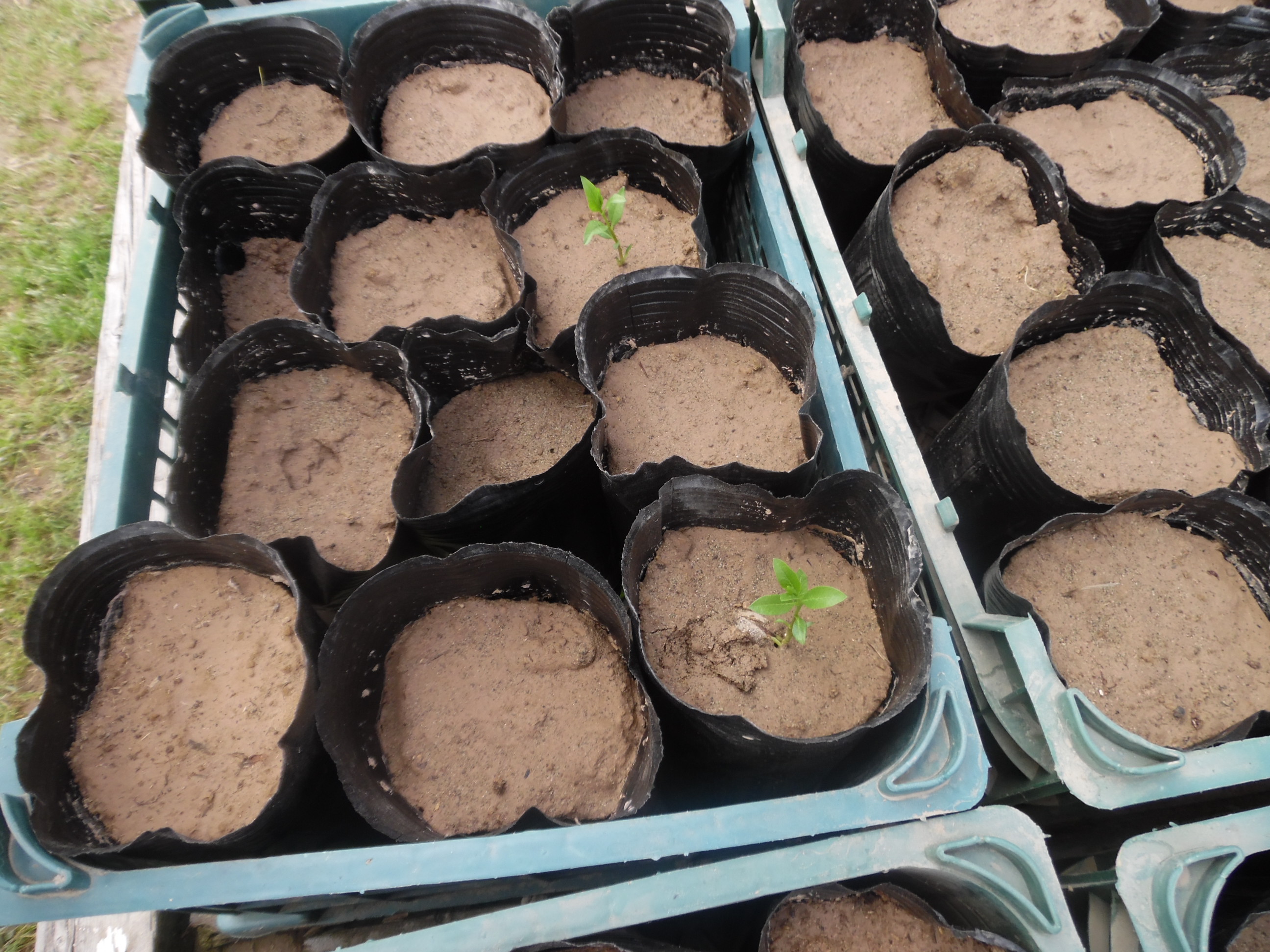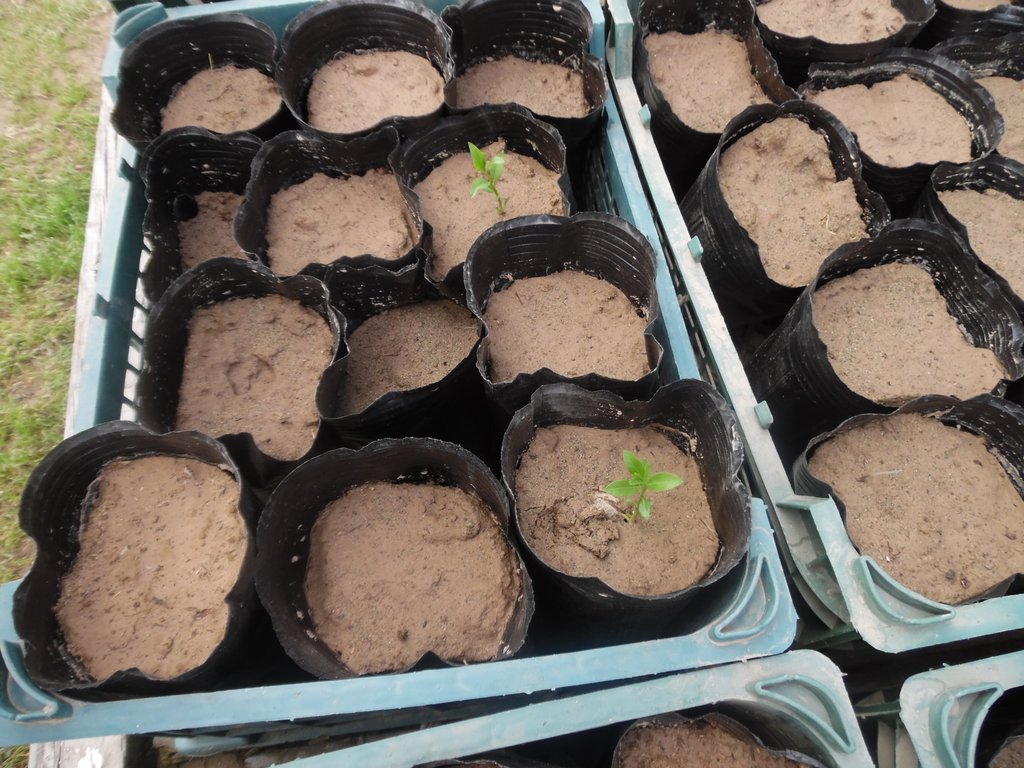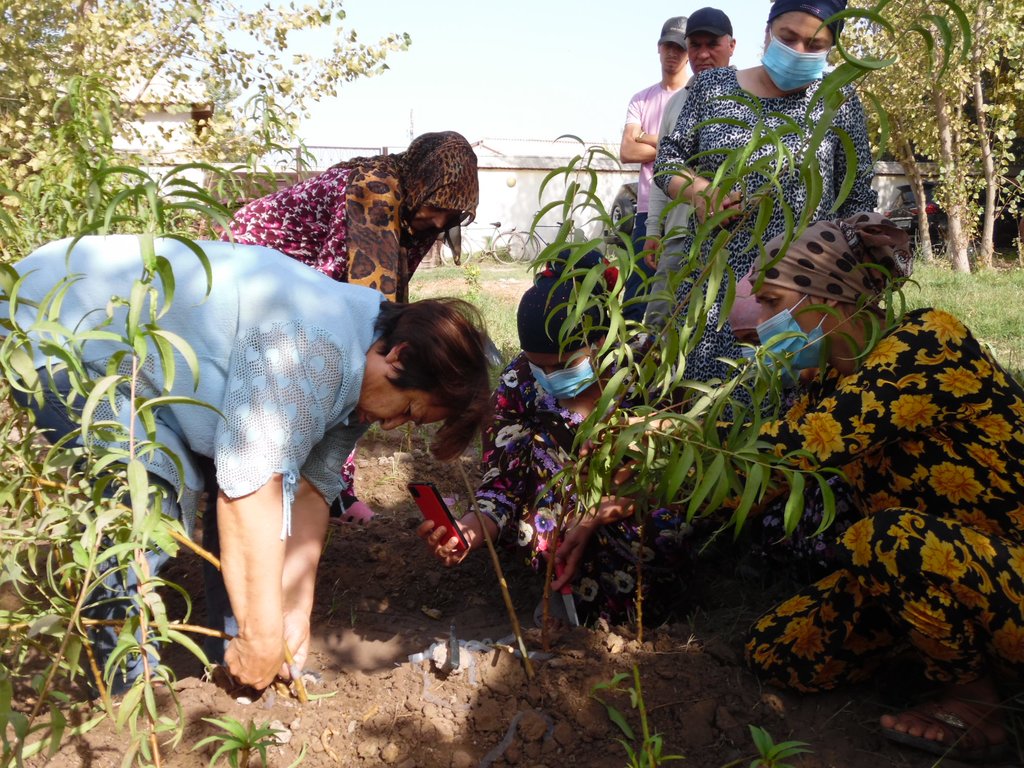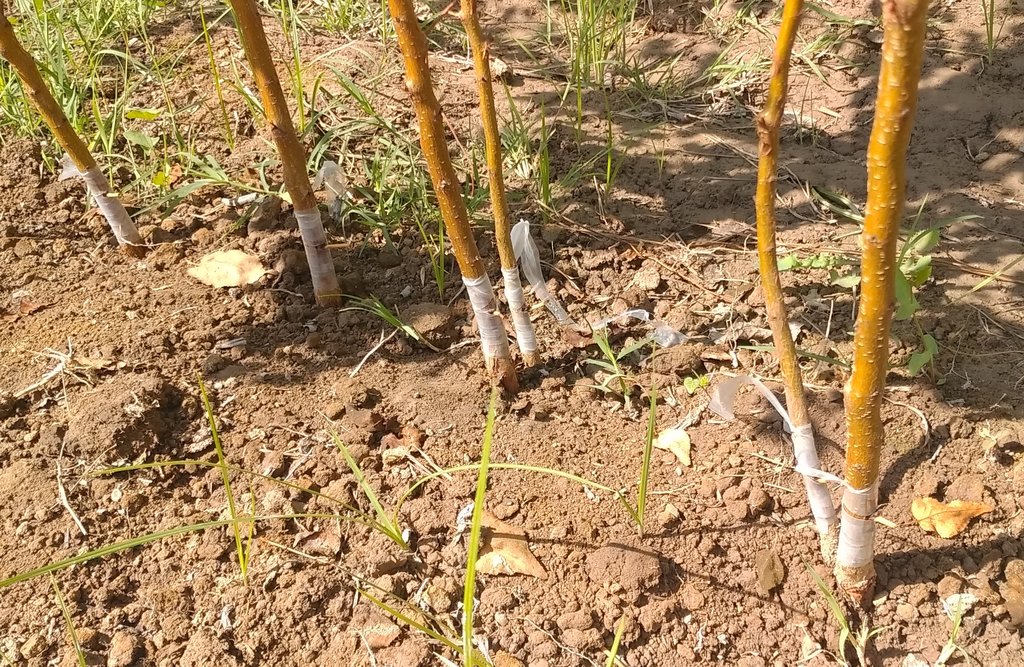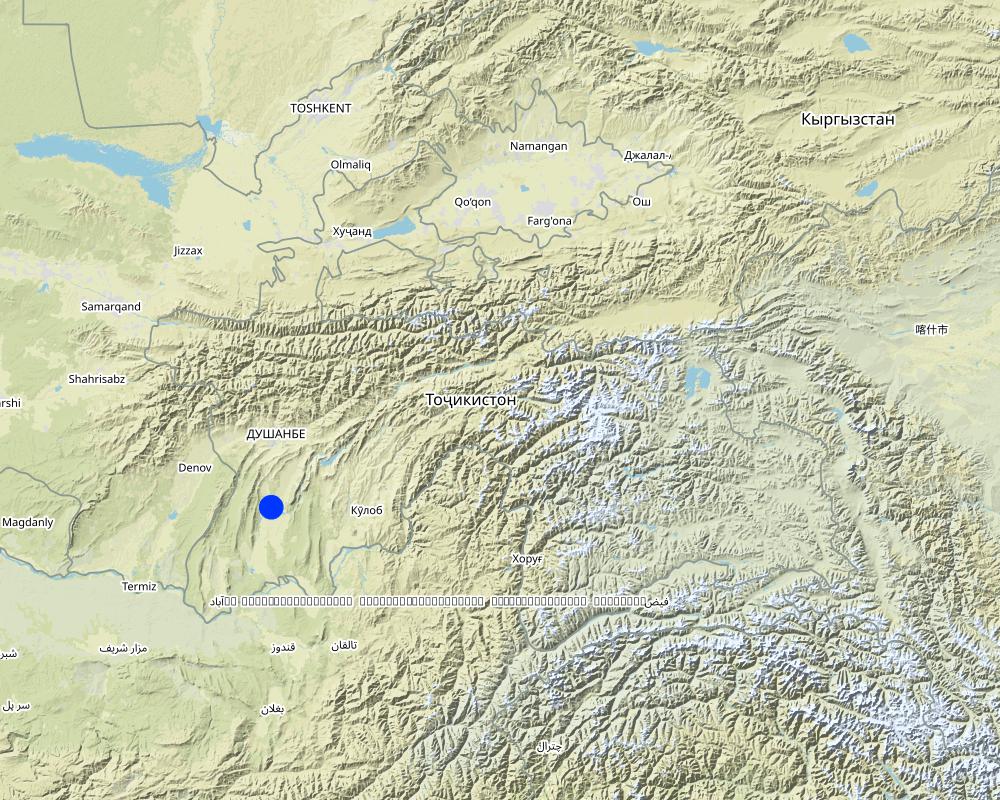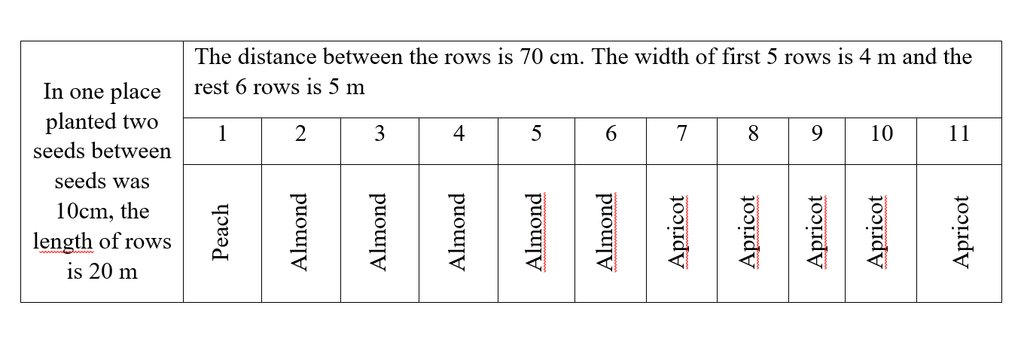Production of drought-resistant fruit seedlings by women's groups. [Tajikistan]
- Creation:
- Update:
- Compiler: Daler Domullodzhanov
- Editor: –
- Reviewers: William Critchley, Rima Mekdaschi Studer
Истеҳсоли ниҳолҳои дарахтони ба хушкӣ тобовар ва мевадиҳанда аз ҷониби гуруҳи занон.
technologies_6165 - Tajikistan
View sections
Expand all Collapse all1. General information
1.2 Contact details of resource persons and institutions involved in the assessment and documentation of the Technology
Name of project which facilitated the documentation/ evaluation of the Technology (if relevant)
Integrated natural resources management in drought-prone and salt-affected agricultural production landscapes in Central Asia and Turkey ((CACILM-2))Name of the institution(s) which facilitated the documentation/ evaluation of the Technology (if relevant)
FAO Tajikistan (FAO Tajikistan) - Tajikistan1.3 Conditions regarding the use of data documented through WOCAT
The compiler and key resource person(s) accept the conditions regarding the use of data documented through WOCAT:
Yes
1.4 Declaration on sustainability of the described Technology
Is the Technology described here problematic with regard to land degradation, so that it cannot be declared a sustainable land management technology?
No
2. Description of the SLM Technology
2.1 Short description of the Technology
Definition of the Technology:
Drought-resistant fruit seedlings are being produced by vulnerable, women-led households in backyard nurseries. These will be planted out in agroforestry plots within the dry agrolandscapes of Southern Tajikistan.
2.2 Detailed description of the Technology
Description:
The availability of high-quality and drought-resistant fruit tree saplings is a major constraint to establishing agroforestry plots in the extremely dry agrolandscapes of Southern Tajikistan. While productive, these trees - Almonds, Apricots and Peaches - planted in agroforestry systems can help fight desertification through stabilizing slopes and reducing soil erosion. The FAO/GEF financed CACILM2 project promotes the establishment of backyard nurseries through farmer groups, formed in the targeted districts. The FAO project has coached women's group members to establish nurseries in their kitchen gardens. Season-long training workshops were held for groups of farmers (dominated by women) starting from the selection of better adapted, more productive, drought-resistant varieties. Training was also given on planting/transplanting, grafting, applying fertilizers and preparation of seedlings for transplantation. Farmer groups members have established nurseries in their kitchen gardens on plots of 200-300 square metres: each square metre can produce 20-30 grafted seedlings.
2.3 Photos of the Technology
2.5 Country/ region/ locations where the Technology has been applied and which are covered by this assessment
Country:
Tajikistan
Region/ State/ Province:
Khatlon region, A. Jomi district
Further specification of location:
Mushkurut village
Specify the spread of the Technology:
- evenly spread over an area
If precise area is not known, indicate approximate area covered:
- < 0.1 km2 (10 ha)
Is/are the technology site(s) located in a permanently protected area?
No
Map
×2.6 Date of implementation
If precise year is not known, indicate approximate date:
- less than 10 years ago (recently)
2.7 Introduction of the Technology
Specify how the Technology was introduced:
- through projects/ external interventions
3. Classification of the SLM Technology
3.1 Main purpose(s) of the Technology
- improve production
- reduce, prevent, restore land degradation
- reduce risk of disasters
- adapt to climate change/ extremes and its impacts
- mitigate climate change and its impacts
3.2 Current land use type(s) where the Technology is applied
Land use mixed within the same land unit:
No

Other
Specify:
Kitchen garden plots
3.3 Has land use changed due to the implementation of the Technology?
Has land use changed due to the implementation of the Technology?
- Yes (Please fill out the questions below with regard to the land use before implementation of the Technology)
Land use mixed within the same land unit:
No

Other
Specify:
kitchen garden plots
3.4 Water supply
Water supply for the land on which the Technology is applied:
- full irrigation
3.5 SLM group to which the Technology belongs
- agroforestry
- windbreak/ shelterbelt
- home gardens
3.6 SLM measures comprising the Technology

vegetative measures
- V1: Tree and shrub cover

management measures
- M1: Change of land use type
3.7 Main types of land degradation addressed by the Technology

soil erosion by water
- Wt: loss of topsoil/ surface erosion
- Wg: gully erosion/ gullying

soil erosion by wind
- Et: loss of topsoil
- Ed: deflation and deposition
3.8 Prevention, reduction, or restoration of land degradation
Specify the goal of the Technology with regard to land degradation:
- prevent land degradation
- reduce land degradation
4. Technical specifications, implementation activities, inputs, and costs
4.1 Technical drawing of the Technology
Technical specifications (related to technical drawing):
The total area under 11 rows (4 m x 20m = 80, 5m x 40m = 200) occupied for the seedling production is 280 m2.
Author:
Marufqul Mahkamov
Date:
02/03/2021
4.2 General information regarding the calculation of inputs and costs
Specify how costs and inputs were calculated:
- per Technology area
Indicate size and area unit:
280 sq m
Specify currency used for cost calculations:
- USD
4.3 Establishment activities
| Activity | Timing (season) | |
|---|---|---|
| 1. | Plowing of the land by hand | April |
| 2. | Preparing the rows for the planting | April |
| 3. | Planting by hand | April |
| 4. | Inter-row cultivation | May |
| 5. | First time application of fertilizers, by hand | May - June |
| 6. | Mannual weeding | June - July |
| 7. | Second time application of fertilizers, by hand | July |
| 8. | Monitoring and providing consultations | March-September |
| 9. | Grafting | June-July |
| 10. | Recording activities in a field book | March-September |
4.4 Costs and inputs needed for establishment
| Specify input | Unit | Quantity | Costs per Unit | Total costs per input | % of costs borne by land users | |
|---|---|---|---|---|---|---|
| Labour | Plowing of the land by hand, preparing the rows for the planting and planting seeds by hand | man days | 2.5 | 50.0 | 125.0 | 100.0 |
| Labour | Inter row cultivation and manual weeding | man days | 1.8 | 30.0 | 54.0 | 100.0 |
| Labour | Two times application of fertilizers, by hand | man days | 1.0 | 10.0 | 10.0 | 100.0 |
| Labour | Grafting | man days | 1.4 | 50.0 | 70.0 | |
| Equipment | Grafting tools | set | 1.0 | 20.0 | 20.0 | |
| Plant material | Seed of almond, apricot and peach | kg | 11.3 | 10.0 | 113.0 | |
| Fertilizers and biocides | Mineral fertilizers | kg | 45.3 | 0.7 | 31.71 | |
| Other | Monitoring and providing consultations | man days | 0.5 | 50.0 | 25.0 | |
| Other | Recording the activities realization in the field book | man days | 1.0 | 20.0 | 20.0 | 100.0 |
| Other | Arranging of training on backyard nursery | man days | 1.0 | 50.0 | 50.0 | |
| Total costs for establishment of the Technology | 518.71 | |||||
| Total costs for establishment of the Technology in USD | 518.71 | |||||
If land user bore less than 100% of costs, indicate who covered the remaining costs:
FAO CACILM-2 project
4.5 Maintenance/ recurrent activities
| Activity | Timing/ frequency | |
|---|---|---|
| 1. | Inter row cultivation | May |
| 2. | First time application of fertilizers, by hand | May - June |
| 3. | Mannual weeding | June - July |
| 4. | Second time application of fertilizers, by hand | July |
| 5. | Monitoring and providing consultations | March - September |
| 6. | Recording the activities realization in the field book | March - September |
4.6 Costs and inputs needed for maintenance/ recurrent activities (per year)
| Specify input | Unit | Quantity | Costs per Unit | Total costs per input | % of costs borne by land users | |
|---|---|---|---|---|---|---|
| Labour | Inter row cultivation and mannual weeding | man days | 1.8 | 30.0 | 54.0 | 100.0 |
| Labour | Two times application of fertilizers, by hand | man days | 1.0 | 10.0 | 10.0 | 100.0 |
| Labour | Monitoring and providing consultations | man days | 0.5 | 50.0 | 25.0 | 100.0 |
| Labour | Recording the activities realization in the field book | man days | 1.0 | 20.0 | 20.0 | 100.0 |
| Fertilizers and biocides | Mineral fertilizers | kg | 45.3 | 0.7 | 31.71 | 100.0 |
| Total costs for maintenance of the Technology | 140.71 | |||||
| Total costs for maintenance of the Technology in USD | 140.71 | |||||
4.7 Most important factors affecting the costs
Describe the most determinate factors affecting the costs:
High inflation rate
5. Natural and human environment
5.1 Climate
Annual rainfall
- < 250 mm
- 251-500 mm
- 501-750 mm
- 751-1,000 mm
- 1,001-1,500 mm
- 1,501-2,000 mm
- 2,001-3,000 mm
- 3,001-4,000 mm
- > 4,000 mm
Specify average annual rainfall (if known), in mm:
455.00
Agro-climatic zone
- arid
5.2 Topography
Slopes on average:
- flat (0-2%)
- gentle (3-5%)
- moderate (6-10%)
- rolling (11-15%)
- hilly (16-30%)
- steep (31-60%)
- very steep (>60%)
Landforms:
- plateau/plains
- ridges
- mountain slopes
- hill slopes
- footslopes
- valley floors
Altitudinal zone:
- 0-100 m a.s.l.
- 101-500 m a.s.l.
- 501-1,000 m a.s.l.
- 1,001-1,500 m a.s.l.
- 1,501-2,000 m a.s.l.
- 2,001-2,500 m a.s.l.
- 2,501-3,000 m a.s.l.
- 3,001-4,000 m a.s.l.
- > 4,000 m a.s.l.
Indicate if the Technology is specifically applied in:
- convex situations
5.3 Soils
Soil depth on average:
- very shallow (0-20 cm)
- shallow (21-50 cm)
- moderately deep (51-80 cm)
- deep (81-120 cm)
- very deep (> 120 cm)
Soil texture (topsoil):
- medium (loamy, silty)
Soil texture (> 20 cm below surface):
- medium (loamy, silty)
Topsoil organic matter:
- medium (1-3%)
5.4 Water availability and quality
Ground water table:
< 5 m
Availability of surface water:
good
Water quality (untreated):
good drinking water
Water quality refers to:
ground water
Is water salinity a problem?
No
Is flooding of the area occurring?
No
5.5 Biodiversity
Species diversity:
- high
Habitat diversity:
- high
5.6 Characteristics of land users applying the Technology
Sedentary or nomadic:
- Sedentary
Market orientation of production system:
- mixed (subsistence/ commercial)
Off-farm income:
- 10-50% of all income
Relative level of wealth:
- average
Individuals or groups:
- individual/ household
Level of mechanization:
- manual work
Gender:
- women
Age of land users:
- middle-aged
5.7 Average area of land used by land users applying the Technology
- < 0.5 ha
- 0.5-1 ha
- 1-2 ha
- 2-5 ha
- 5-15 ha
- 15-50 ha
- 50-100 ha
- 100-500 ha
- 500-1,000 ha
- 1,000-10,000 ha
- > 10,000 ha
Is this considered small-, medium- or large-scale (referring to local context)?
- small-scale
5.8 Land ownership, land use rights, and water use rights
Land ownership:
- individual, titled
Land use rights:
- individual
Water use rights:
- communal (organized)
Are land use rights based on a traditional legal system?
Yes
5.9 Access to services and infrastructure
health:
- poor
- moderate
- good
education:
- poor
- moderate
- good
technical assistance:
- poor
- moderate
- good
employment (e.g. off-farm):
- poor
- moderate
- good
markets:
- poor
- moderate
- good
energy:
- poor
- moderate
- good
roads and transport:
- poor
- moderate
- good
drinking water and sanitation:
- poor
- moderate
- good
financial services:
- poor
- moderate
- good
6. Impacts and concluding statements
6.1 On-site impacts the Technology has shown
Socio-economic impacts
Income and costs
expenses on agricultural inputs
Quantity before SLM:
HIgh
Quantity after SLM:
Low
Comments/ specify:
The cost of seedlings decreased
farm income
Quantity before SLM:
Low
Quantity after SLM:
High
Comments/ specify:
The income from the kitchen garden increased.
Ecological impacts
Climate and disaster risk reduction
drought impacts
Quantity before SLM:
Low
Quantity after SLM:
High
Comments/ specify:
The farmers produce drought-resistant seedlings to enhance farmers' resistance to climate change challenges.
6.2 Off-site impacts the Technology has shown
impact of greenhouse gases
Quantity before SLM:
low
Quantity after SLM:
high
Comments/ specify:
The produced seedlings will help to establish and increase the agroforestry area, and will decrease GHG emissions.
6.3 Exposure and sensitivity of the Technology to gradual climate change and climate-related extremes/ disasters (as perceived by land users)
Climate-related extremes (disasters)
Meteorological disasters
| How does the Technology cope with it? | |
|---|---|
| local hailstorm | not well at all |
| local snowstorm | not well |
| local windstorm | not well |
Climatological disasters
| How does the Technology cope with it? | |
|---|---|
| heatwave | moderately |
| drought | moderately |
| forest fire | not well at all |
Hydrological disasters
| How does the Technology cope with it? | |
|---|---|
| landslide | not well at all |
6.4 Cost-benefit analysis
How do the benefits compare with the establishment costs (from land users’ perspective)?
Short-term returns:
positive
Long-term returns:
very positive
How do the benefits compare with the maintenance/ recurrent costs (from land users' perspective)?
Short-term returns:
very positive
Long-term returns:
positive
6.5 Adoption of the Technology
- single cases/ experimental
Of all those who have adopted the Technology, how many did so spontaneously, i.e. without receiving any material incentives/ payments?
- 0-10%
6.6 Adaptation
Has the Technology been modified recently to adapt to changing conditions?
No
6.7 Strengths/ advantages/ opportunities of the Technology
| Strengths/ advantages/ opportunities in the land user’s view |
|---|
| The ToT training workshops for promotors and best female farmers on the topics of establishing backyard nurseries were delivered to enable the active farmers from the different districts to continue the promotion of the techniques. |
| The production of drought-resistant and fruit seedlings is diversifying income-generating activities in the kitchen garden plots. |
6.8 Weaknesses/ disadvantages/ risks of the Technology and ways of overcoming them
| Weaknesses/ disadvantages/ risks in the land user’s view | How can they be overcome? |
|---|---|
| Partial provision of the agriculture inputs for free can negatively affect the promotion of the best SLM techniques after the project life span. | To find a co-financing source and/or to increase the co-financing ratio by the farmers. |
| As the growing period of seedlings is 2-3 years, despite high-level payback it takes a long to receive the first income. | To find another source of income for vulnerable families. To get microcredits to cover the financial shortage. |
7. References and links
7.1 Methods/ sources of information
- field visits, field surveys
Regular field visit to A.Jomi district
- interviews with SLM specialists/ experts
The project specialists provided information on the progress of farmers.
When were the data compiled (in the field)?
13/09/2021
7.2 References to available publications
Title, author, year, ISBN:
Regular CACILM2 project's Bullitin "Dialogue"
Available from where? Costs?
It is free publication and available in the FAO web site
7.4 General comments
More detailed information related to SLM and CSA technologies promoted by FAO/GEF CACILM-2 project is available in the annual reports and other promotional materials.
Links and modules
Expand all Collapse allLinks
No links
Modules
No modules


